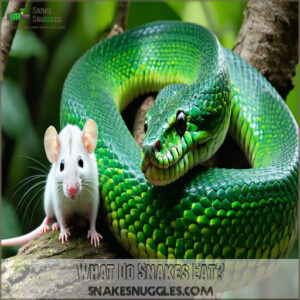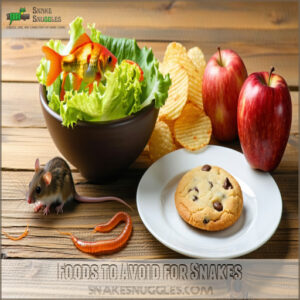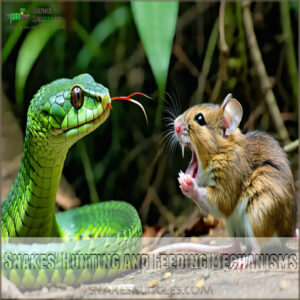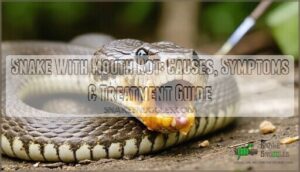This site is supported by our readers. We may earn a commission, at no cost to you, if you purchase through links.
 Snakes aren’t picky eaters, but they do stick to meat—they’re strict carnivores.
Snakes aren’t picky eaters, but they do stick to meat—they’re strict carnivores.
They don’t chew; instead, they swallow their meals whole, thanks to their stretchy jaws.
Depending on the species, they’ll gobble up rodents, birds, fish, amphibians, and even other snakes.
Some have a thing for eggs too!
For instance, rattlesnakes go for mammals and birds, while garter snakes enjoy fish and insects.
Sea snakes? They’re all about fish and eels.
Just keep in mind that snakes can’t handle fruits, veggies, or grains—those are digestive no-gos.
Curious how their hunting tricks vary by species?
Stick around to uncover some wild methods!
Table Of Contents
- Key Takeaways
- What Do Snakes Eat?
- Do Snakes Eat Fruit?
- Foods to Avoid for Snakes
- Snake Predation on Squirrels
- Diet Variations Among Snake Species
- Snakes’ Hunting and Feeding Mechanisms
- Frequently Asked Questions (FAQs)
- What animals do snakes typically eat?
- What insects do snakes typically eat?
- Are there any animals that snakes do not eat?
- Do snakes eat other snakes?
- What foods do snakes eat?
- Will a snake eat a cockroach?
- Will a snake eat a squirrel?
- What does a snake eat in 30 words?
- What kind of food do snakes eat?
- Do snakes eat fruit?
- Conclusion
Key Takeaways
- Snakes are strict carnivores, eating anything they can swallow whole, like rodents, birds, fish, amphibians, and even other snakes.
- They don’t chew their food; they rely on stretchy jaws to engulf and swallow prey whole.
- Different snake species have unique diets: rattlesnakes prefer mammals and birds, garter snakes go for fish and insects, while sea snakes focus on fish and eels.
- Fruits, vegetables, and grains are completely off their menu since their digestive systems can’t process plant materials.
What Do Snakes Eat?
Ever wondered what snakes eat?
These fascinating creatures have a diet as wild as their reputation.
Snakes are strict carnivores, which means they stick to a meat-only menu.
Depending on the species, their meals might include rodents, birds, amphibians, reptiles, or even fish.
Some snakes get pretty adventurous, swallowing prey like eggs or even other snakes—it’s a literal snack attack!
Snakes don’t chew; they swallow their food whole, thanks to flexible jaws.
This might sound like a magic trick, but it’s all about surviving in the food chain.
Smaller or younger snakes munch more often because of a high metabolism, while the big guys can go weeks—or months—between meals.
For specific dietary needs, consult a reptile veterinarian.
In the case of snake diets in captivity, frozen prey like mice is a safe bet.
Keep the water bowl full, though—hydration is key for healthy reptile nutrition!
Do Snakes Eat Fruit?
Let’s clear this up: no, snakes don’t eat fruit.
As strict carnivores, their digestive systems just aren’t built for handling plants or sugary snacks.
It’s all about meat for these slithery hunters.
Here’s why fruit is a no-go:
- Snake anatomy: They’re designed to swallow prey whole, not nibble on berries.
- Nutritional needs: Animal proteins give snakes the nutrition they need.
- Digestion: Plant material would be tough for them to break down.
Stick to proper prey to keep your snake healthy!
Foods to Avoid for Snakes
Some things just don’t belong on a snake’s menu.
You might wonder, "Do snakes eat small vegetables or fruits?" Nope—they’re pure meat lovers.
Vegetables, fruits, and grains don’t sit well with their digestion and lack the nutrients snakes need.
A food bad for snakes, like goldfish, contains thiaminase, which messes with their nutrition.
Even some worms, like red worms, can harm them.
Understanding a proper snake diet guide is essential for their health and longevity.
Stick to prey that’s safe, like frozen mice or fish.
Feeding live prey might sound “natural,” but it’s risky—your snake could get hurt.
And wild prey? It’s like letting your snake eat without checking the expiration date—parasites and diseases are common.
Here’s a quick glance at foods that snakes should avoid:
| Category | Why Avoid? | Examples |
|---|---|---|
| Processed Foods | No nutritional value | Cookies, chips |
| Wild Prey | Parasites/disease risks | Frogs, rodents |
| Toxic Foods | Harmful built-in enzymes | Goldfish, red worms |
Feed appropriately-sized frozen prey, and your snake will stay happy and healthy.
Snake Predation on Squirrels
Did you know snakes eat squirrels? It’s true—these hyperactive rodents aren’t always quick enough to escape their scaly predators.
And whether they’re scampering through trees or nesting in cozy burrows, squirrels are prime targets for certain snake species. Tree snakes wait patiently for their moment, while others, like ground-dwelling serpents, chase squirrels down in dramatic hunts. Even hibernating squirrels aren’t completely safe!
Here’s why squirrels make ideal snake prey:
- Rich in nutrition: Squirrels provide essential energy for snakes.
- Widespread in habitats: They’re found where many snake predators live.
- Limited defenses: While alarm calls work sometimes, they’re not foolproof.
- Size match: Squirrels are perfect for mid-to-large snakes to swallow whole.
- Tree or ground vulnerability: Snakes hunt wherever squirrels settle.
So, “do snakes eat squirrels?” Absolutely—and it’s all part of maintaining balance in forest ecology.
Diet Variations Among Snake Species
Snakes don’t all eat the same thing—what they hunt depends on their size, species, and where they live.
Some prefer rodents, while others go for fish, eggs, or even other snakes!
Rattlesnakes
If you’ve ever wondered, “What do rattlesnakes eat?” the answer is as varied as their habitats.
These snakes snack on plenty, including:
- Small mammals like mice, rats, and squirrels
- Birds and their eggs
- Amphibians and lizards
- Other snakes
Rattlesnakes are ambush predators, relying on their heat-sensing pits to track prey.
Their venom isn’t just for defense—it paralyzes and starts digesting their meals.
For a closer examination into snake diets, explore this informative guide on snake diet for different species.
Found in deserts, forests, and swamps, they play a big role in controlling pest populations.
Pythons
Pythons, unlike rattlesnakes, rely on constriction to subdue their prey.
Found in rainforests to grasslands, these non-venomous giants like Burmese and Reticulated pythons feast on birds, rodents, and even deer.
Their jaws stretch wide, swallowing meals whole.
If you’re wondering, “What do pythons eat?”—almost anything they can overpower!
For python care, stick to frozen prey for safety.
Do pythons eat rattlesnakes? Rarely.
King Cobras
King cobras, the longest venomous snake, have a fascinatingly narrow menu—you could call them the picky eaters of the snake world.
Living mostly in Southeast Asia’s dense forests (their prime cobra habitat), they snack on a diet dominated by other snakes, venomous ones included.
Talk about daring! Occasionally, they’ll mix it up with lizards, birds, or rodents.
Their hunting tactics rely on sharp senses, striking speed, and neurotoxin-packed venom—the effects are fatal for prey.
With a slow metabolism, these carnivorous snakes can feast once and chill for weeks without wondering “what do snakes eat” next.
Garter Snakes
Regarding garter snake habits, these non-picky eaters have an impressive menu.
From small fish to amphibians and earthworms, their diet adjusts to available prey.
Garter snakes, known for pest control, even snack on insects and small rodents—talk about a natural exterminator!
Here’s what makes them stand out:
- Garter snakes hunt both on land and in water. Thanks to their swimming skills, fish and amphibians are easy targets.
- Some species are mildly venomous. Don’t worry, their venom won’t hurt humans.
- Garter snakes give birth to live young. No eggs here, this makes them a unique reptile!
Curious about snake feeding habits? They swallow prey whole—no chewing required!
Sea Snakes
Sea snakes are like the ocean’s sneaky hunters, totally built for water life.
They stick to a carnivorous diet, munching on fish, eels, and even venomous prey like gobies.
Their saltwater adaptation lets them digest meals in their salty surroundings—a nifty skill if you ask me!
Their marine prey and hunting habits are a fascinating mix of stealth and venom precision.
Check out this quick exploration into their eating habits:
| Trait | Details |
|---|---|
| Favorite Prey | Fish, eels, gobies |
| Hunting Style | Stealth, venom delivery |
| Unique Ability | Months without food |
Pollution, though, is putting these carnivorous reptiles at risk.
Snakes’ Hunting and Feeding Mechanisms
Snakes are crafty hunters with wild tricks up their scales.
Many rely on ambush tactics, lying still until prey stumbles close.
Their prey detection methods involve heat-sensing pits and flicking tongues to "sniff" scents.
Venomous species use venom delivery systems to paralyze prey, while constrictors like boas squeeze tightly to suffocate theirs.
Snakes use a multisensory hunting arsenal to locate and subdue their prey.
When it’s time to eat, their jaws stretch wide, swallowing meals whole—bones and all!
Digestion is a slow process, showing how snakes’ feeding behaviors are perfectly adapted to their diets and habitats.
Frequently Asked Questions (FAQs)
What animals do snakes typically eat?
Snakes eat mammals, birds, amphibians, fish, reptiles, and insects, depending on their species and habitat.
They’re not picky—anything they can swallow whole is fair game, from tiny mice to large antelope.
What insects do snakes typically eat?
Some snakes snack on bugs like crickets, grasshoppers, and beetles, especially smaller species or juveniles.
They’ll even go for caterpillars or termites.
Think of it as nature’s all-you-can-eat insect buffet for tiny predators!
Are there any animals that snakes do not eat?
Oddly enough, snakes won’t touch plants—they’re hardcore carnivores.
They also avoid prey they can’t overpower or digest, like large adult elephants or rhinos.
Some poisonous or spiny animals are off the menu too—no self-inflicted drama!
Do snakes eat other snakes?
Some snakes, like kingsnakes, are specialists at hunting other snakes, even venomous ones.
It sounds intense, but snakes eating snakes is just nature’s way of keeping the balance in the wild.
What foods do snakes eat?
Snakes eat meat, covering everything from mice and birds to frogs and even other snakes.
Some munch insects or worms, while bigger snakes handle deer or crocs.
No veggies here – they’re all about protein!
Will a snake eat a cockroach?
The early bird may get the worm, but some snakes will snap up a cockroach.
While not a favorite choice, small snakes like ringnecks or garter snakes might munch on roaches if they’re available.
Will a snake eat a squirrel?
A snake might eat a squirrel if it’s small enough to be swallowed whole.
Larger snakes, like pythons or boas, are more likely to tackle squirrels, but smaller snakes usually stick to tinier prey.
What does a snake eat in 30 words?
Imagine a snake’s menu as nature’s buffet—they’ll eat rodents, birds, frogs, lizards, insects, and even other snakes.
Some specialize in eggs, while giants like pythons tackle mammals.
It’s all about what they can swallow whole, which encompasses their diet ranging from small creatures to large prey like mammals.
What kind of food do snakes eat?
You’d be surprised—snakes eat anything they can swallow whole.
From mice and frogs to eggs and even other snakes, their menu depends on their species and size.
Big snakes? They’ve tackled crocs and antelope!
Do snakes eat fruit?
Feeding a snake fruit is like offering salad to a lion—it just doesn’t work.
Snakes are purely carnivores, needing meat to survive.
Their diet’s all about rodents, reptiles, or insects, but never fruit!
Conclusion
Snakes swallow, slither, and surprise with their diverse diets!
Whether it’s rodents, fish, birds, or even other snakes, they’re strict carnivores and never touch fruits or veggies.
Different species bring unique tastes—rattlesnakes love mammals, garter snakes nibble on insects, and sea snakes fish for, well, fish.
You’ll see that what snakes eat depends on their size, hunting tricks, and habitat.
Fascinated by what snakes eat? Keep learning; there’s always more to these stealthy predators!
- https://www.petmd.com/reptile/nutrition/what-do-pet-snakes-eat
- https://www.discoverwildlife.com/animal-facts/reptiles/what-do-snakes-eat
- https://www.crittercontrol.com/wildlife/snakes/snake-diet/
- https://vcahospitals.com/know-your-pet/snakes-feeding
- https://www.reddit.com/r/snakes/comments/1byltq4/if_your_snake_will_only_eat_live_youre_doing/









